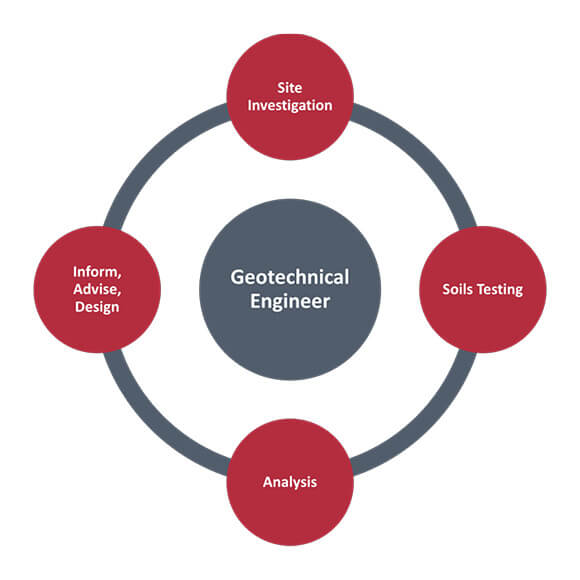10 Easy Facts About Geotheta Described
Table of ContentsThe Single Strategy To Use For GeothetaA Biased View of GeothetaThe Ultimate Guide To Geotheta5 Simple Techniques For GeothetaGeotheta Fundamentals Explained

They conduct site examinations, gather examples, perform research laboratory tests, and examine data to review the suitability of the ground for construction projects - Geo Tech Engineer. Based upon their searchings for, geotechnical engineers supply recommendations for structure style, incline security, retaining frameworks, and mitigation of geotechnical threats. They work together with various other professionals, such as engineers, structural engineers, and building groups, to guarantee that geotechnical considerations are incorporated right into the general job layout and implementation
By evaluating the behavior and buildings of soil and rock, they can determine possible geotechnical threats such as landslides, dirt negotiation, or slope instability. Their knowledge assists prevent failings or accidents that might endanger lives and residential or commercial property. Below are some in-depth obligations and obligations of a geotechnical engineer: Site Examination: Geotechnical engineers conduct website examinations to gather data on subsurface conditions.
They analyze the data to understand the residential properties and actions of the dirt and rock, including their strength, permeability, compaction qualities, and groundwater problems. Geotechnical Evaluation and Style: Geotechnical engineers examine the information collected throughout website investigations to evaluate the security and suitability of the site for building projects. They carry out geotechnical estimations and modeling to evaluate factors such as bearing capacity, settlement, incline stability, side planet stress, and groundwater flow.
All about Geotheta
Structure Layout: Geotechnical engineers play a critical role in making foundations that can safely sustain the intended structure. They assess the soil problems and lots requirements to identify the appropriate structure type, such as superficial foundations (e.g., footings), deep foundations (e.g (https://fliphtml5.com/homepage/bdjcx/geotheta/)., stacks), or specialized methods like dirt enhancement. They consider factors such as settlement limits, birthing capacity, and soil-structure interaction to create ideal foundation layouts
They evaluate building plans, monitor website tasks, and carry out area evaluations to validate that the design suggestions are followed. If unpredicted geotechnical problems develop, they analyze the scenario and provide suggestions for removal or changes to the design. Risk Analysis and Mitigation: Geotechnical designers analyze geotechnical threats and dangers related to the task site, such as landslides, liquefaction, or dirt erosion.

Collaboration and Communication: Geotechnical designers work closely with other experts included in a task, such as engineers, architectural designers, and building groups. Effective communication and partnership are necessary to integrate geotechnical factors to consider into the overall job layout and building and construction process. Geotechnical engineers provide technological competence, response queries, and ensure that geotechnical demands are fulfilled.
The smart Trick of Geotheta That Nobody is Discussing
Below are some kinds of geotechnical engineers: Foundation Engineer: Foundation designers concentrate on developing and examining foundations for frameworks. They assess the dirt conditions, load demands, and site attributes to figure out the most proper structure kind and style, such as shallow foundations, deep foundations, or specialized techniques like heap foundations.
They review the variables affecting incline security, such as dirt properties, groundwater problems, and incline geometry, and establish approaches to avoid slope failures and alleviate threats. Earthquake Engineer: Quake engineers focus on examining and creating frameworks to endure seismic pressures. They examine the seismic hazard of a website, examine dirt liquefaction possibility, and develop seismic style criteria to make certain the security and resilience of structures throughout earthquakes.
They perform area testing, gather samples, and analyze the collected information to identify the dirt buildings, geologic formations, and groundwater conditions at a site. Geotechnical Instrumentation Designer: Geotechnical instrumentation engineers concentrate on surveillance and gauging the behavior of soil, rock, and structures. They mount and maintain instrumentation systems that monitor factors such as dirt settlement, groundwater degrees, slope activities, and architectural displacements to analyze performance and provide early warnings of possible issues.
Indicators on Geotheta You Need To Know
They perform tests such as triaxial tests, consolidation examinations, straight shear examinations, and permeability examinations to gather data for geotechnical evaluation and layout. Geosynthetics Engineer: Geosynthetics engineers focus on the style and application of geosynthetic products, such as geotextiles, geogrids, and geomembranes. They make use of these materials to enhance soil stability, reinforce inclines, offer drain solutions, and control erosion.
They have a tendency to be investigatory people, which indicates they're intellectual, reflective, and investigative. They are interested, systematic, sensible, logical, and rational. Some of them are likewise social, indicating they're kind, generous, cooperative, person, caring, useful, empathetic, sensible, and friendly - Engineer of Record.
In the office environment, geotechnical designers use specialized software application tools to perform computations, produce layouts, and analyze information. They prepare reports, review job requirements, interact with customers and employee, and coordinate job tasks. The office setup provides a helpful environment for research, analysis, and cooperation with various other experts included in the job.
All about Geotheta
They often see job websites to conduct website investigations, assess geotechnical problems, and collect information for evaluation. These brows through involve traveling to different areas, in some cases in remote or challenging surfaces. Geotechnical designers might execute soil tasting, conduct examinations, like it and screen building and construction activities to guarantee that the geotechnical facets of the project are being carried out properly.
Geotechnical engineers also function in specialized geotechnical research laboratories. Geotechnical lab designers function extensively in these environments, taking care of screening devices, operating instruments, and recording data.